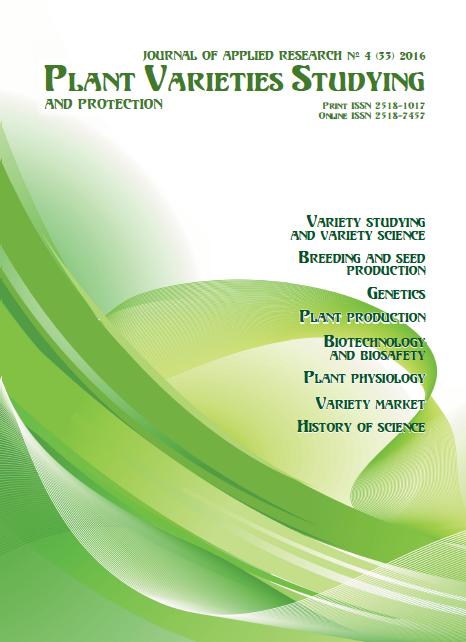Features of accumulation of inorganic elements in seeds of white mustard (Sinapis alba L.) and black mustard (Brassica nigra L.)
DOI:
https://doi.org/10.21498/2518-1017.4(33).2016.88688Keywords:
mustard, seed, heavy metals, maximum permissible limit, ICP-MS detection, phytoremediationAbstract
Purpose. To investigate special aspects of accumulation of inorganic elements including heavy metals in seeds of white and black mustard to be grown for obtaining drugs.
Methods. Field experiments, microwave digestion, ICP-MS and statistical analysis.
Results. The content of inorganic elements including heavy metals was determined in the seeds of white and black mustard grown in Kiev Oblast. It was revealed that during the growing season plants of white mustard were able to accumulate such elements as aluminum, barium, strontium, zinc in seeds in concentrations that exceed their content in black mustard seeds, while compounds of calcium, cesium, iron, magnesium, manganese, potassium in a greater degree were accumulated in black mustard seeds.
Conclusions. As legal and regulatory documents for important chemical elements don’t contain the maximum permissible limits of their content in medicinal plants, it would make sense to launch a comprehensive research with the involvement of specialists of relevant profiles in order to establish such a gradation. Plants of white and black mustard in Kiev Oblast have accumulated high levels of such metals as Ba, Cu, Fe, Mn, Mo, Sr, Zn that exceed the known limits of accumulation, indicating a partial contamination of soils in the region. Consequently, these plants can be used for phytoremediation of soils. Considering the fact that in the pharmaceutical practice refined mustard seed oil is used, revealed alterations of metal accumulation in seeds will not affect the quality of the final drugs. According to the research results, white and black mustard is promising for cultivation in Kiev Oblast with a view to obtain raw material that can be processed into drugs.
Downloads
References
Evans W. C. (1996). Trease and Evans’ Pharmacognosy. (14th ed.) (рр. 36–40). London: W. B. Saunders Со. Ltd.
The United States Pharmacopeia, XXXX; The National Formulary, XXXV (2016). Retrieved from http://www.usp.org/usp-nf.
Vavilov, N. I. (1926). Tsentry proiskhozhdeniya kul’turnykh rasteniy [Studies on the Origin of Cultivated Plants]. Leningrad: Tipografiya imeni Gutenberga [in Russian]
Hadza, P. I. (Ed.). (2014). Hirchytsia [Mustard]. Ivano-Frankivsk: Nova era. [in Ukrainian]
Arkhypenko, F. M., Voitovyk, M. V., & Oksymets, O. L. (2000). Mustard as oilseed and fodder crop. Zbirnyk naukovykh prats Instytutu zemlerobstva UAAN [Collection of Scientific Papers of the Institute of agriculture UAAS], 1, 48–51. [in Ukrainian]
Likarski zasoby. Nalezhna praktyka kultyvuvannia ta zbyrannia vykhidnoi syrovyny roslynnoho pokhodzhennia. ST-N MOZU 42-4.5:2012 [Good practice of cultivation and harvesting of raw materials of plant origin]. (2012). Retrieved from http://www.moz.gov.ua/docfiles/N118_2013_dod1.pdf [in Ukrainian]
Sarma, H., Deka, S., Deka, H., & Saikia, R. R. (2011). Accumulation of Heavy Metals in Selected Medicinal Plants. Rev Environ Contam Toxicol, 214, 63–86. doi: 10.1007/978-1-4614-0668-6_4
Vashkulat, N. P., Palgov, V. I., Spektor, D. R., & Dudnik, V. P. (2002). Establishing levels of heavy metals in soils of Ukraine. Dovkillia ta zdorovia [Environment & Health], 2, 44–46. [in Russian]
World Health Organization. (1998). Quality control methods for medicinal plant materials. Geneva: World Health Organization.
Downloads
Published
How to Cite
Issue
Section
License
Copyright (c) 2016 Ukrainian Institute for Plant Variety Examination

This work is licensed under a Creative Commons Attribution-ShareAlike 4.0 International License.
Starting in 2022, the copyright to the publication remains with the authors
Our journal abides by the CREATIVE COMMONS copyright rights and permissions for open access journals.
Authors, who are published in this journal, agree to the following conditions:
- The authors reserve the right to authorship of the work and pass the first publication right of this work to the journal under the terms of a Creative Commons Attribution License, which allows others to freely distribute the published research with the obligatory reference to the authors of the original work and the first publication of the work in this journal.
- The authors have the right to conclude separate supplement agreements that relate to non-exclusive work distribution in the form in which it has been published by the journal (for example, to upload the work to the online storage of the journal or publish it as part of a monograph), provided that the reference to the first publication of the work in this journal is included.

























 Ukrainian Institute for Plant Varieties Examination
Ukrainian Institute for Plant Varieties Examination  Селекційно-генетичний інститут
Селекційно-генетичний інститут Institute of Plant Physiology and Genetics of the National Academy of Sciences of Ukraine
Institute of Plant Physiology and Genetics of the National Academy of Sciences of Ukraine
 The National Academy of Agrarian Sciences of Ukraine
The National Academy of Agrarian Sciences of Ukraine